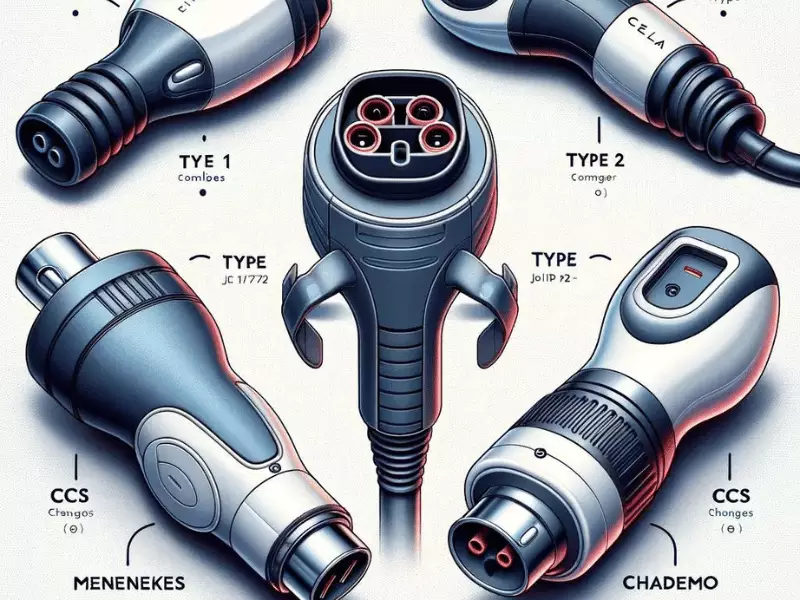With the rapid development of electric vehicle technology, various charging connectors have appeared on the market, which support various charging methods from slow home charging to high-speed public charging stations.
This article will introduce in detail the types, characteristics, and application scenarios of various electric vehicle charging connectors to help consumers better understand their advantages and applicability, to make more informed choices.
Table of Contents
ToggleWhat are EV Charging Connectors

An electric vehicle charging connector is a plug or interface designed for charging electric vehicles and is used to connect electric vehicles to a power source or charging station. Its core function is to transmit electricity so that the batteries of electric vehicles can be charged.
This kind of connector comes in many forms according to different standards and specifications, such as Type 1, Type 2, CCS (Combined Charging System), CHAdeMO, etc.
EV Charging Levels
- Level 1 (120V AC): Uses standard household outlets and provides a charging rate of about 4-5 miles of range per hour. Suitable for overnight charging or for plug-in hybrids with smaller battery packs.
- Level 2 (240V AC): Requires a dedicated charging station and can deliver about 15-25 miles of range per hour. Ideal for home charging setups and public charging stations where quicker turnaround is needed.
- Level 3 (DC Fast Charging): Uses direct current (DC) and offers rapid charging, providing up to 80% charge in 20-30 minutes. Commonly found at commercial charging stations and is ideal for long-distance travel.
Types of EV Charging Connectors

1. Type 1 (SAE J1772)
Type 1 connector, also known as the J1772 connector, is an electric vehicle charging interface widely used in North America and Japan. This connector has a five-pin design, supports Level 1 and Level 2 charging, and can typically provide up to 7.2 kW of power. It’s compatible with most electric vehicles sold in the United States and Japan, including the Nissan Leaf, Chevrolet Volt, and others.
Advantages
- Universally available in North America and Japan.
- Reliable and straightforward to use.
- This connector has a simple and robust construction that can withstand the wear and tear of daily use.
- Equipped with a safety locking mechanism to prevent accidental disconnection during charging.
Disadvantages
- Not suitable for DC fast charging, limiting its use to slower charging applications.
- Type 1 connectors typically only support single-phase power
2. Type 2 (Mennekes)
The Type 2 connector, also known as the Mennekes connector, is a European standard that uses a seven-pin design and supports three-phase AC charging up to 43 kW.
Available for DC fast charging up to 350 kW via additional pins, commonly used in European electric vehicles such as the BMW i3, Renault Zoe and Tesla models (with adapter).
Advantages
- Highly versatile and supports higher power levels for faster AC charging.
- Widely adopted across Europe, ensuring compatibility with many charging stations.
- Several safety features, such as temperature control and automatic locking mechanisms, are included in the design to ensure a safe charging process.
Disadvantages
- Requires adapters for use outside of Europe, adding complexity for international travelers.
- Type 2 connectors may require additional electrical upgrades during home installation, which increases the initial investment.
3. Combined Charging System (CCS)
Combined charging systems (CCS) combine the functionality of alternating current (AC) and direct current (DC) charging in a single connector. CCS comes in two variants: CCS1 (based on Type 1) and CCS2 (based on Type 2), both types of CCS support AC charging up to 43 kW and DC fast charging up to 350 kW.
They do this by combining a standard Type 1 or Type 2 connector with two additional DC pins. Due to its efficient charging capabilities, CCS is widely adopted by most European and American car manufacturers.
Advantages
- Future-proof solution that supports both slow and fast charging.
- Increasingly becoming the standard for new EVs, ensuring broad compatibility.
Disadvantages
- More complex and expensive compared to single-function connectors.
- May require different adapters or configurations based on regional standards.
4. CHAdeMO
The CHAdeMO connector is a device developed in Japan specifically for DC fast charging, and the name stands for “CHARge de MOve”.
The connector will initially support charging powers up to 62.5 kW, while future versions are expected to support up to 400 kW and is specifically designed for fast and efficient DC charging. Japanese electric vehicles such as the Nissan Leaf and Mitsubishi i-MiEV are equipped with this type of connector.
Advantages
- Reliable and has an established network of charging stations in Japan and parts of Europe.
- Allows for bidirectional charging, enabling vehicle-to-grid applications.
Disadvantages
- Generally slower than CCS for DC fast charging.
- Competing standards like CCS may limit its adoption in regions outside Japan.
5. Tesla Connector
Tesla uses a proprietary charging connector for its vehicles, a compact connector that supports both AC charging and DC charging. It can be used at home charging stations and Tesla’s Supercharger network, providing Level 2 AC charging and DC fast charging.
While adapters are available on the market to be compatible with other types of connectors, this proprietary connector only works on Tesla vehicles.
Advantages
- Offers high-power delivery, making it one of the fastest charging options available.
- Supported by Tesla’s extensive Supercharger network, which is widely available and reliable.
Disadvantages
- The proprietary nature limits compatibility with non-Tesla vehicles without adapters.
- Tesla vehicles in regions outside North America may need adapters to use local charging infrastructure.
Regional Variations in EV Charging Connectors
1. North America
- Standards: Predominantly uses Type 1 (SAE J1772) and CCS1 connectors.
- Tesla: Tesla vehicles use a proprietary connector but can use J1772 and CCS1 with adapters.
- Network: Public charging networks like ChargePoint, EVgo, and Electrify America support these standards, ensuring wide availability.
2. Europe
- Standards: Type 2 (Mennekes) and CCS2 are the standard connectors.
- Tesla: Uses Type 2 for AC charging and a modified version for DC charging at Superchargers.
- Network: Extensive public charging infrastructure supports these connectors, with networks like Ionity and Allego providing broad coverage.
3. Asia
- Japan: Primarily uses CHAdeMO and Type 1 connectors.
- China: Has its own GB/T standard, which is distinct from other regions but widely used within the country.
- Network: Japan has a well-established CHAdeMO network, while China has rapidly expanded its GB/T charging infrastructure.
Future Developments in EV Charging Connectors
1. Increased Power Levels
- Goal: Advancements in charging technology aim to increase the power delivery of DC fast chargers, significantly reducing charging times.
- Impact: Higher power levels will enable EVs to charge faster, making long-distance travel more convenient and reducing wait times at charging stations.
2. Standardization Efforts
- Initiatives: Efforts are underway to standardize connectors globally to ensure compatibility and ease of use for EV owners.
- Benefits: Standardization will simplify the charging process, reduce the need for multiple adapters, and potentially lower costs for manufacturers and consumers.
3. Wireless Charging
- Technology: Wireless charging, or inductive charging, eliminates the need for physical connectors, offering convenience and ease of use.
- Development: Emerging technology with pilot projects and early implementations in some regions.
- Potential: Could become widely adopted, especially for home and public charging setups, if efficiency and cost-effectiveness improve.
Choosing the Right Connector for Your EV
1. Consider Your Vehicle’s Compatibility
- Check Manufacturer Specifications: Ensure your vehicle supports the type of connector you plan to use.
- Regional Standards: Be aware of regional variations and the availability of charging stations that support your vehicle’s connector.
2. Evaluate Charging Speed Requirements
- Daily Commutes vs. Long Trips: Consider how quickly you need to charge your vehicle based on your typical usage patterns.
- Home Charging: Level 2 chargers are typically sufficient for overnight home charging, while DC fast chargers are more suited for quick top-ups during travel.
3. Assess Regional Availability
- Local Charging Infrastructure: Ensure the chosen connector type is widely available in your area and along routes you frequently travel.
- Future Expansion: Consider the potential expansion of charging networks and any upcoming standardization efforts that may affect your choice.
Conclusion
According to this article, understanding the different types of electric vehicle charging connectors can help you choose a more suitable connector. Whether you’re charging at home or on the go, understanding the capabilities and compatibility of each connector type can ensure you can power your electric vehicle efficiently and conveniently.
As electric vehicle charging technology and standardization progress, the prospects for electric vehicle charging connectors will continue to evolve, providing more convenient and faster charging solutions.
The Moreday website provides multiple types of EV charging. You can click to contact our sales staff to get accurate and preferential quotes.


